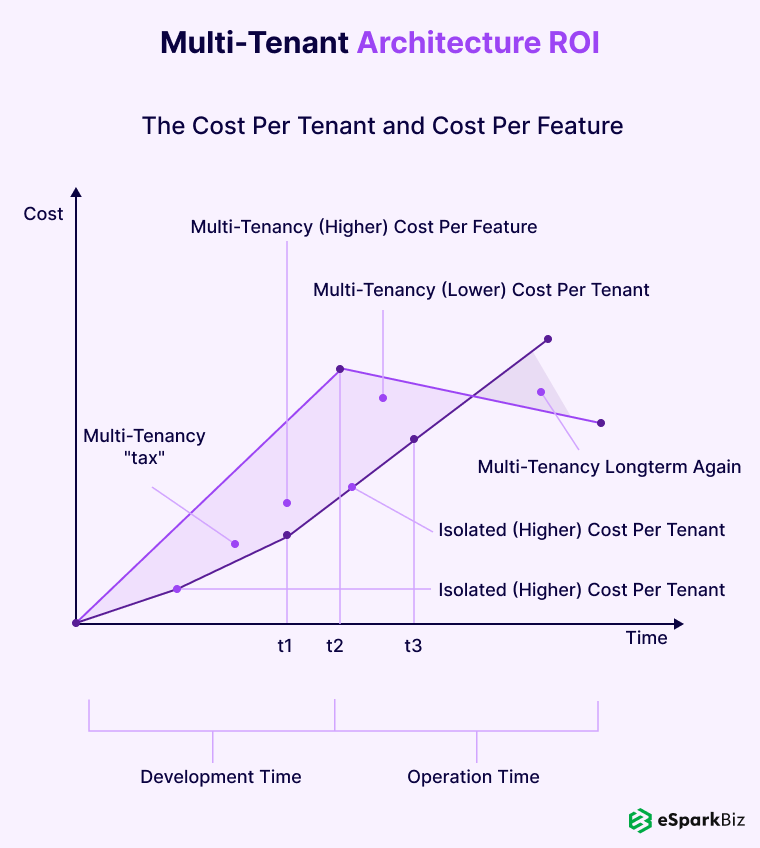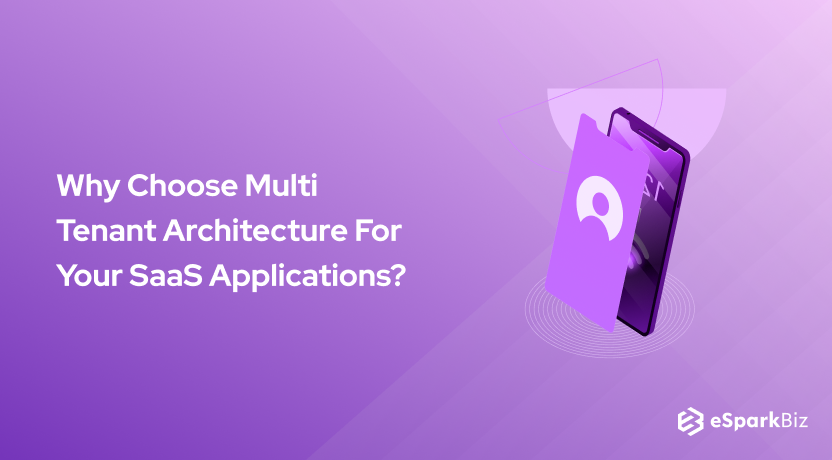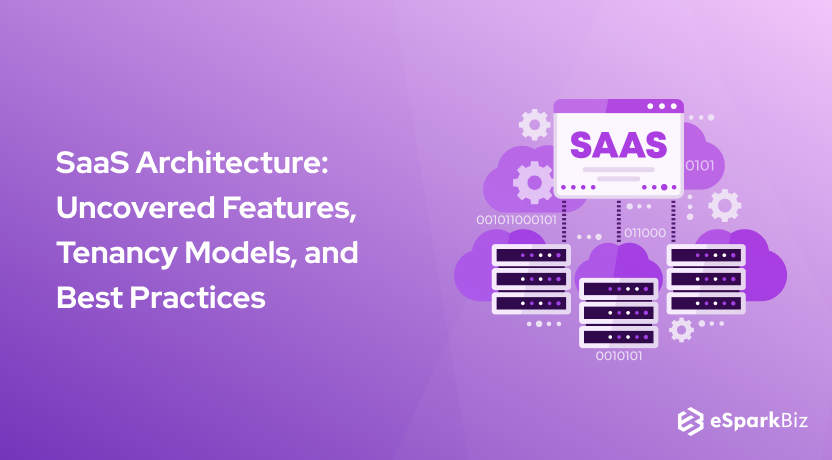Over the years, we have observed that organizations around the world have started adopting cloud computing in business operations. This is because it helps to reduce costs and take the user experience to a new level. Today, we will talk about the Multi-Tenant Architecture in detail.
As per Gartner, Cloud computing $1.3 trillion in revenues in 2022 and is anticipated to reach $1.8 trillion in 2025.
Out of various services in cloud computing, SaaS gained a lot of traction in the software industry. So, you need to have an idea of the Cost To Develop a SaaS Application.
Here, in this blog, we have a closer look at both, the Single & multi-tenant App Architecture and why you should choose multi-tenant for your SaaS Application.
Reasons to Choose Multitenant Architecture For SaaS
Some of the most essential reasons to choose SaaS Multitenant architecture for your SaaS application are given below:
Better ROI for SaaS Multitenant architecture

Multi-Tenant architecture aids in decreasing the overall investment cost in the SaaS app in a long interval of time.
As the resources, databases, and applications are shared with other tenants, due to which it’s the cost is much lower as compared with the single-tenant architecture.
Also, as the individuals are accessing the same application and database, this drops the cost of development and maintenance.
It is quite quick for a vendor to provide a SaaS solution at a reasonable price rather than get a Single-Tenant SaaS Solution.
Moreover, with every new tenant added, no extra cost has to be levied from the vendors’ side, thus reducing the tenant’s investment cost.
Improved Performance with SaaS architecture
As the different attributes of the technology stack are in sharing, the SaaS architecture provides top-notch speed, efficiency, and authenticity.
The vendor provides the developer with shared code, attributes of the technology stack, and databases of different tenants simultaneously.
Due to this, it becomes suitable for a vendor to utilize and enhance the speed, the response over the whole system, and upgrade the tech stack whenever required.
Hence, we can say that performance is the most important identifier of multi-tenant architecture. Moreover, with the increase in shareability, there is an increase in the chances of threats.
Bur, over the years, these multi-tenant architectures have been changing and integrating different things to get rid of threats and vulnerabilities.
Expedient Maintenance & Updates
In multi-tenant architecture, there are no changes happening in the data structure because of the sharing of the code.
Moreover, it’s simple to modify the technology stack or the app as all the changes can be done from a single centralized point; however, there is a reflection at all the tenant points.
The total cost of maintenance reduces because of the sharing by the tenants whenever any updates happen. These things occur to every event because of code sharing.
It’s a handier for developers to maintain an application built using the multi tenant architecture as the code & the entire data structures are shared and any small or big upgrade is made available for uses instantly.
Convenient Onboarding & New Tenants
Bad user experience is one of the main reasons behind the decrease in the number of targeted clients. Therefore, it is highly essential for businesses to attract customers and users on board for utilizing the product.
Also, businesses need to make sure that there is a streamlining of the entire process. To achieve this, you need to design architecture as per the customer’s needs and that offers fast processing. Also, the app should be good enough to allow users to self-sign-up.
Hence, multi-tenant architecture offers the best method to make the complete signing up and configuration of the subdomain/domain process automated.
The app instantly carries out tasks such as setup of default data for clients and configuration of the app, lastly allowing users to configure the app without any hindrance.
Offers more Scalability
When there is an integration of new hardware into the SaaS multi-tenant, there is pumping in the horsepower of the whole process, thus offering more scalability to existing and new tenants.
Several times, it’s quicker to introduce more hardware in the running resources of the technology stack.
As compared with the Single-Tenant solution, a vendor doesn’t have to create a fresh and unique data center for every new tenant while utilizing the multi tenant architecture.
In multi tenant applications, tenants access one common infrastructure. There is no requirement to increase data centers for every tenant.
Reduce the cost in the long run
Today, every client is looking at the possibility of utilizing maximum resources while spending the minimum amount of money. That’s where the Multitenant architecture of SaaS application comes into the picture. It helps you to reduce the cost in the long run.
Multi Tenant SaaS Application can share databases, resources, and applications. Therefore, you get good value for money in comparisonto the single-tenant application. Another major USP of Multi-Tenant architecture is that is doesn’t require new software resources.
So, the cost of onboarding a new tenant in this space would be zero or negligible hike in comparison to the single-tenant application.
Adding in New Customer Is Easy
The addition of new customers has always been a major challenge for software vendors around the globe. Sometimes the new onboarding process can lead to the downfall of the efficiency. So, implementing the right technique for adding new customers is vital.
The multi tenant architecture gives the option of automatic sign up to the customers. Domain and sub-domain configuration is also automatic. So, you should definitely look at this paradigm for the SaaS application in the near future.
Maximizing Resource Usage
One of the major advantages of multi-tenant Application Architecture is its power to properly maximize the usage of resources.
The possibility to access the common infrastructure and resources is responsible for making tasks like maintenance and utilization automated. Additionally, if a customer is not using any resources, another tenant who can use it instantly gets that resource.
Also Read: Exploring The Various Challenges Of Cloud Computing In Detail
Provides Higher Efficiency
SaaS multi tenant Architecture provides next-gen speed and reliability. As here the entire code elements present in the technology stack and databases are in sharing, it’s quick to maximize speed, utilization, and the overall response time.
Moreover, SaaS multi-tenant is responsible for optimizing the entire system for every individual. Due to this, the customers don’t need to add extra server capacity.
Security Remains Standard
Security is the most crucial thing available in multi tenant architecture. It makes sure that the security remains standard for all the earlier, current, and future customers.
From the perspective of technicality, all the customers are accessing the same app; hence, security is the same for all.
As of now, we will briefly compare single and multi tenant architecture.
Single Tenant vs Multi-Tenant Architecture

As you have made up your mind to use SaaS for your web application project, rest assured that it will benefit you in the long run. Moreover, 90% of enterprises love to access different cloud services and platforms in 2024.
Here, we will help you choose a SaaS single-tenant or SaaS multi-tenant for the SaaS application, but before that, you should be familiar with the term Tenant.
A tenant is the sharing of computing resources in a public or private network, which is separate and kept invisible from other users.
Now, let’s understand in detail what is a single-tenant architecture and what is meant by multi-tenant architecture in a SaaS application.
What is Single-Tenancy?
Single Tenant Architecture is basically an independent architecture and a copy of the software that is meant to serve a single customer. In other words, here only a single copy of the software is enabled to run on the SaaS server per client.
In this type of SaaS, the server & the architecture aren’t shared with the software instances, which gives the client full freedom of customization.
An example of this can be a tenant with a neighborhood of detached houses. All the clients have their own house (meaning software copy, web application) and can customize it as per the requirement.
What is Multi-Tenancy?
In SaaS multi-tenant application architecture, the same copy of the application is shared between various clients in the network
All the customers can access a similar application, share resources with other members; however, they possess a separate database.
In other words, Multi Tenant architecture consists of a centralized administration to handle the ideal codebase of an application and run the same instances of an application for multiple tenants.
An excellent example of SaaS Multi-Tenancy would be a school building, where all the facilities like boards, internet, library, electricity, etc. are shared with all the students, teachers, and other members of an organization.
Conclusion
Multitenant architecture best suited for any SaaS application due to its remarkable advantages: higher efficiency, scalability, reduced cost, etc.
Lastly, if you want to upgrade from single-tenant to multi tenant architecture or build a new application around multi tenant architecture, you can approach a web application development company like us.
We can understand your idea and provide an effective application for your saas development company.
-
Why Multitenancy Is Important?
Multitenancy allows you to make optimum use of resources and reduce the maintenance as well as the operational cost. So, it is highly recommended.
-
Is AWS Multitenant?
The simple answer to this question would be YES. The Lamda software provided by AWS is multitenant in nature.
-
What Are The Three Multitenant Models?
Complete Multi-Tenant, Single-Tenant App & Single-Tenant Database.
-
Can SaaS Be Single-Tenant?
The simple answer to this question would be YES. SaaS can be Single-Tenant as per your needs.









